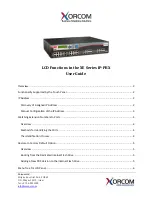
1.3 Packet Control Features
1.3.1 Jitter Buffer
When voice signals are packetized and transmitted, individual packets can take different paths through the
network and arrive at the destination at varied timings. This is referred to as "jitter", and it can cause degradation
in speech quality. To compensate for jitter problems, the "jitter buffer" accumulates the packets temporarily for
processing.
To set the size of the jitter buffer, refer to "3.4 [1-1] Slot—Card Property - IPCMPR—VoIP-DSP Option" in the
PC Programming Manual.
1.3.2 Voice Activity Detection (VAD)
The VAD conserves bandwidth by detecting silent periods during a call and suppressing the packets of silence
from being sent to the network. This feature can be enabled or disabled for each available codec: G.711 and
G.729A.
To configure the VAD feature, refer to the appropriate section in the PC Programming Manual.
Note
•
To use the VAD feature for a certain codec, be sure to enable it for that codec on both the local and
remote gateway devices.
•
When connecting the PBX to a KX-TDE or KX-TDA series PBX:
–
The VAD feature cannot be used between the V-IPGW16 and IP-GW4 cards since the
V-IPGW16 card does not support the G.723 codec (although calls can be made and received as
normal).
–
The VAD feature between the V-IPGW16 and IP-GW16 cards can be enabled through system
programming. Refer to "Main—
Connection for IP-GW16" under "3.11 [1-1] Slot—Shelf Property
- Virtual IP Gateway—GW Settings" in the PC Programming Manual.
Document Version 2009-12
IP Networking Guide
11
1.3.2 Voice Activity Detection (VAD)
Summary of Contents for KX-NCP500
Page 3: ...Section 1 Introduction Document Version 2009 12 IP Networking Guide 3...
Page 12: ...12 IP Networking Guide Document Version 2009 12 1 3 2 Voice Activity Detection VAD...
Page 13: ...Section 2 Guidance for VoIP Installation Document Version 2009 12 IP Networking Guide 13...
Page 31: ...Section 4 Programming Document Version 2009 12 IP Networking Guide 31...
Page 91: ...Section 5 Appendix Document Version 2009 12 IP Networking Guide 91...

































